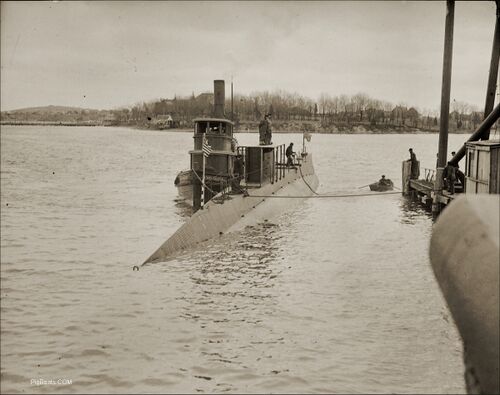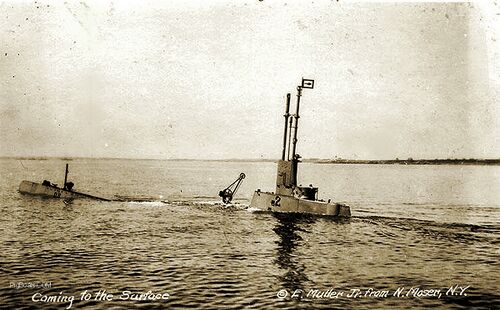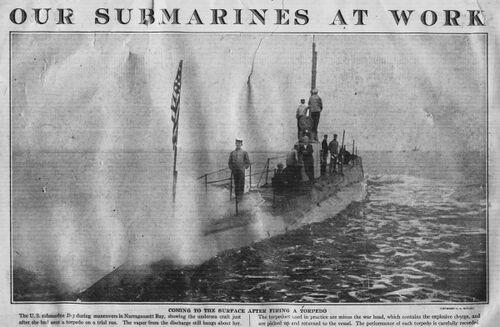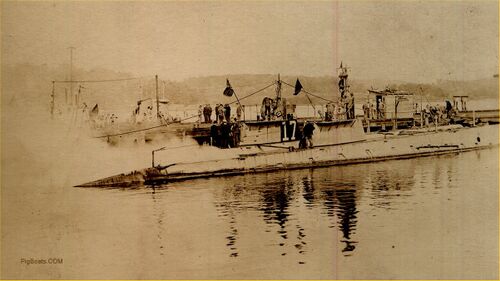D-3

U.S. Navy photo.

Salmon after her launch on March 12, 1910 from Fore River Shipbuilding being maneuvered to the dock by a tug and the small group of yard workers that were aboard the sub during her launch. A temporary platform has been built over the top of the bridge fairwater. It is still early spring and the trees are still lacking their leaves.
U.S. Navy photo.

Salmon at the fitting out pier at Fore River Shipbuilding, Quincy, MA. on March 30, 1910. She had five more months until commissioning.
Photo from the private collection of Ric Hedman

Salmon crew on deck while the boat was in Bermuda in late 1910. The man leaning against the lifeline on the right does not "look Navy", and may have been a civilian, possibly the harbor pilot.
Photo courtesy of the Submarine Force Library & Museum.

Salmon anchored off Hamilton, Bermuda in late 1910. Crew are relaxing topside and are probably the duty section. The remainder of the crew was likely ashore on liberty.
Photo courtesy of the Submarine Force Library & Museum.

Salmon seen alongside at a Navy base somewhere on the east coast, circa late 1910. The other ships in the background are not identified. Sometime around 1911-1912 the boats were repainted haze gray.
Photo from the private collection of Ric Hedman

Salmon running on the surface, likely in Long Island Sound, approximately 1910-1911. The 3 over 3 on her fairwater is a squadron position marker and not her hull number.
U.S. Navy photo.

D-3 on the surface in the company of other submarines (seen on the far left). We are not sure of the date or location, but we estimate this was taken in 1912 or 1913.
Photo from the private collection of Ric Hedman

D-3 in the East River at New York City during the Naval Review on October 4, 1912. A South Carolina-class battleship is in the background.
Photo from the private collection of Ric Hedman

Despite what the caption on this photo says, this shows D-3 most likely diving during a test run, possibly in Cape Cod Bay off Provincetown, MA., approximately 1912. The torpedo loading derrick is in place on the forward deck (the only place it was ever installed), and with that end deeper in the water this is likely a dive. Every once in a while the boats lost control of their angle while surfacing and had a stern-up attitude when the broke the surface. However, this was rare, even more so with these early EB design submarines that used angles and the power of the propulsion plant to make a depth change.
Photo from the private collection of Ric Hedman

D-3 running submerged in Cape Cod Bay off Provincetown, MA., approximately 1912. She is most likely at about 42 feet keel depth. From the top of the tallest periscope to the keel on a D-class submarine was in the range of 48 to 50 feet.
U.S. Navy photo.

Another view of D-3 running submerged in the waters of Cape Cod Bay. She is turning to the left and is running at near her top submerged speed of 9.5 knots. For an unknown reason she has an unusually long flagstaff in place on her aft deck that is sticking up above water.
Photo from the private collection of Ric Hedman

D-3 surfacing after a submerged run in Cape Cod Bay, Massachusetts, 1912. The object just forward of her fairwater is the torpedo loading crane. She may be in the process of running down an exercise torpedo that she recently fired. The weapon was recovered at the end of her run, hauled aboard, refurbished, and put back into service. Note the submarine "fish" flag attached to her #2 periscope.
U.S. Navy photo.
U.S. Navy photos.

D-3 seen here in Key West, Florida. The photo date is late 1912 or January 1913 when she made a cruise with her squadron to the Caribbean. She has the "Battle Efficiency" "E" on her conning tower fairwater. This is an award for a ship that showed excellence in recent engineering inspections and certifications.
There is a large hose coming from the left side of the image and attaches to a fitting either in or next to the forward hatch. This is most likely a fueling hose and a red "Bravo" flag is flying from the starboard signal flag hoist. This means that no open flames or smoking is allowed in the area.
Photo courtesy of the Monroe County Library Collection.

D-3 is seen with 15 members of the crew topside or at least poking a head up through the after hatch (probably the man who is operating the engines). Circa 1915-1916. A previous owner of the card has written "A Submarine" at the top of the card. Most likely when the card was new.
The Commanding Officer, possibly Lieutenant (Junior Grade) Rush S. Fay (but since the date of the photo is unknown this is not certain), and a helmsman are on the bridge.
If indeed this is the time frame, Fay would have been the Commanding Officer and his second in command would have been LT(jg) Robert Henry English, later Admiral English who was COMSUBPAC in WW II until he was killed a airplane crash on January 21, 1943.
There appears to be one Chief on the fore deck and possibly one all the way aft. English may be the first standing man from the bow. Maybe the D-3 was asked to have the crew topside for a photo op.
Photo from the private collection of Ric Hedman

A newspaper clipping of D-3, shown from the starboard quarter shortly after completing a torpedo firing exercise in Narragansett Bay near Newport, Rhode Island. The date is unknown for sure, but is likely 1915-1916. Most of her crew are topside getting some fresh air, and she has just lit off her engines, which are smoking excessively due to being cold.
Newspaper clipping in the private collection of Ric Hedman.

D-3 (closest to camera), D-1, G-4 (Submarine No. 26) (on opposite side of pier) and G-3 (Submarine No. 31) all moored at Submarine Base New London, Groton CT., winter 1917/1918. The Thames River is frozen over and ice can be seen filling the water alongside the submarines. It appears to be a bright sunny day but probably very cold.
U.S. Navy photo.

Submarine Base New London in Groton, CT. where the D-3 is moored outboard of sister boat D-1. Either D-1 or D-3 have started engines, likely for a battery charge. On the far side of the pier is the G-3. it is interesting to note the man repairing the roof of the shed on the pier. Time frame is probably spring/summer 1918.
Photo from the private collection of Ric Hedman

Another photo taken a few minutes before or after the one above. At the left the smoke there seems to be coming from the USS D-1. On the far side of the pier is the USS G-3. The man repairing the roof of the shed on the pier is still there but the men on the dock and decks have all moved. There seems to be a group of civilians on the deck of the D-1. Time frame is probably spring/summer 1918.
Photo from the private collection of Ric Hedman

Photo from the private collection of Ric Hedman

Photo from the Private Collection of Ric Hedman

A commemorative plaque made for the D-3 after her decommissioning and scrapping. It is interesting to note the sponsor's name. Miss Rose Fitzgerald later became the matriarch of the Kennedy dynasty and the mother to President John F. Kennedy.
Photo courtesy of the Submarine Force Library & Museum.
Page created by:
Ric Hedman & David Johnston
1999 - 2023 - PigBoats.COM©
Mountlake Terrace, WA, Norfolk, VA
webmaster at pigboats dot com



